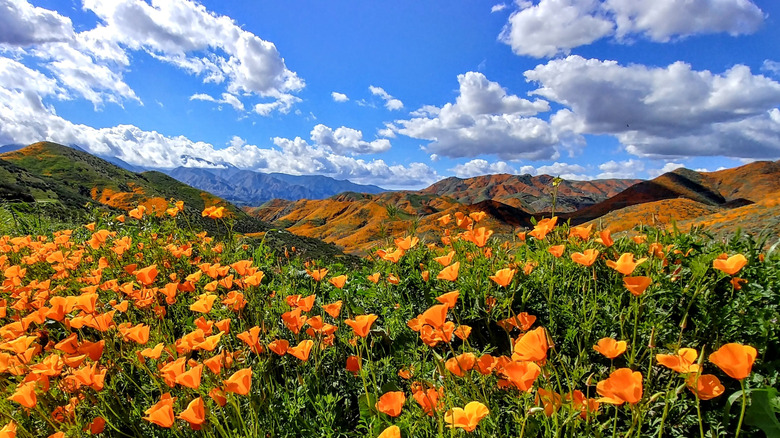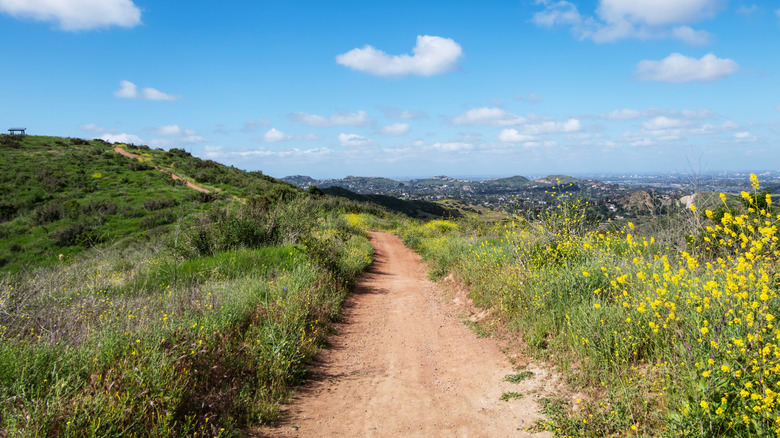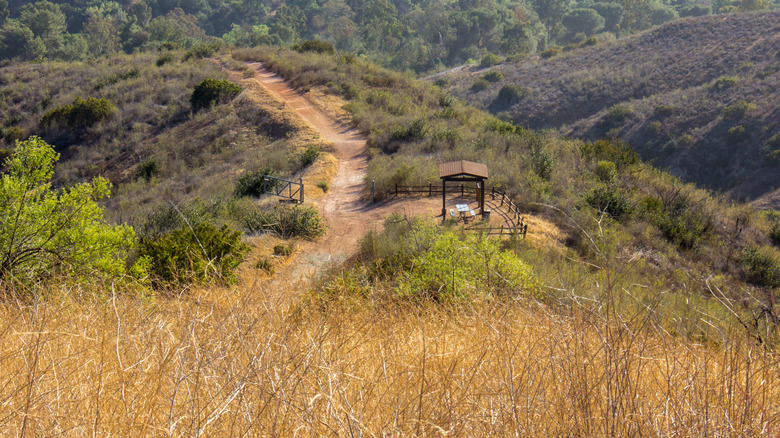California's 'Secluded Refuge' Is An Orange County Park With Charming Mountain Vistas And Rugged Trails
Southern California is a veritable megalopolis, what with its densely populated cities and suburbs sprawling on as far as the eye can see. Still, the region's urban jungles pale in comparison to the vast swaths of wilderness spaces that dominate the land to this day. Take, for example, Orange County's massive regional park system, which gives day-trippers and locals alike the chance to roam the Golden State's rugged terrain, wild and free. This mammoth network of protected areas covers nearly 40,000 acres — over 1,200 of which can be found in the lush Santiago Oaks Regional Park, right on the outskirts of the city of Orange.
Stretching alongside the waters of the Santiago Creek, an offshoot of the Santa Ana River, the park lies about 30 minutes outside of Santa Ana. The city is home to the nearest major airport and is located just outside of Anaheim, the ultimate gateway to California's best family-friendly attractions. Whether you're adventuring solo, with friends, or with kids, Santiago Oaks certainly has something to offer everyone. There are picnic areas, barbecues, and a playground, not to mention miles upon miles of interconnecting trails for humans, dogs, and horses alike. The park even has a wedding and reception venue available to rent for lovebirds looking to get hitched in the great outdoors.
According to the County of Orange, "this secluded refuge offers hikers, bikers and equestrians the natural charm of mountain vistas, an orange grove, a meandering creek and a mature forest of many different species of trees," making it one of the most incredible California spots to visit if you're in the area.
Adventure awaits in Santiago Oaks Regional Park
Ready to get trekking? Santiago Oaks Regional Park has 18 miles of rugged trails, with more than a dozen winding paths for hikers of all skill levels. If you prefer an easy route, set out on the Santiago Creek Trail or the Historic Dam Trail, the latter of which will take you straight to the Santiago Creek Dam, a water storage structure that dates back to 1932. There, you'll find a small waterfall, depending on the time of year, and possibly even some turtles. Just remember, all looking and no touching!
For a more challenging hike, tackle one of the park's difficult paths, such as the Hawk, Grasshopper, or Chutes Ridgeline Trails. If you want something in the middle, try a moderate stroll through the wilds of Santiago Oaks via the Barham Ridge Trail, which comes highly recommended thanks to its scenic vista. "You'll be treated to a gorgeous panoramic view of Orange County," a ranger shared in the park's official brochure, adding that the hike is "well worth the effort."
Be sure to see the historic orange grove near the park's entrance for a glimpse into Santiago Oaks' incredible citrus farming past. Valencia oranges were plentiful in the area long before the park opened in 1977. In the 1930s, many acres of the fruit could be found on the homestead of a man named W. Norment Windes, who previously owned a portion of the park. He built a home on the land downstream from the historic dam, which now serves as the park's Nature Center. Opened to the public in 1981, you can learn about the region's history at the facility's various exhibits, so it's definitely another must-see whilst in the park.
Things to know before visiting Santiago Oaks
It's not hard to see why Santiago Oaks Regional Park is one of the best things to do in Southern California. Open daily from 7 a.m. to sunset, you can find this lush nook of Orange County right off of North Windes Drive — named after Windes himself. There is a fee to park at Santiago Oaks, so be prepared to shell out $3 to enter on weekdays and $5 on weekends, at the time of writing. The entrance fee may increase on holidays or special events. Please keep in mind that the park does close its parking lot when it reaches capacity, so be sure to plan your visit accordingly. Santiago Oaks may also shut down during rainy weather, and due to the risks of muddy paths, the hiking trails may be off limits for up to three days after rainfall.
There are a few important rules you need to know to safely enjoy your visit to the park. For starters, always be on the lookout for potential dangers while out on the trails, such as rattlesnakes, mountain lions, and poison oak. Hunting is not permitted, and you can't swim or wade in the Santiago Creek or nearby lakes. As previously mentioned, the park is dog-friendly. However, your pup must remain leashed at all times. And if you do plan on strolling through the historic grove, there's no stopping to pick the oranges. The view is all the zest you need.


